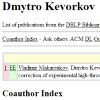| |
 
Hans-Jürgen Bandelt and
Andreas W. M. Dress. Weak hierarchies associated with similarity measures: an additive clustering technique. In BMB, Vol. 51:113-166, 1989.
Keywords: abstract network, clustering, from distances, from trees, phylogenetic network, phylogeny, Program WeakHierarchies, reconstruction, weak hierarchy.
Note: http://dx.doi.org/10.1007/BF02458841.
Toggle abstract
"A new and apparently rather useful and natural concept in cluster analysis is studied: given a similarity measure on a set of objects, a sub-set is regarded as a cluster if any two objects a, b inside this sub-set have greater similarity than any third object outside has to at least one of a, b. These clusters then form a closure system which can be described as a hypergraph without triangles. Conversely, given such a system, one may attach some weight to each cluster and then compose a similarity measure additively, by letting the similarity of a pair be the sum of weights of the clusters containing that particular pair. The original clusters can be reconstructed from the obtained similarity measure. This clustering model is thus located between the general additive clustering model of Shepard and Arabie (1979) and the standard hierarchical model. Potential applications include fitting dendrograms with few additional nonnested clusters and simultaneous representation of some families of multiple dendrograms (in particular, two-dendrogram solutions), as well as assisting the search for phylogenetic relationships by proposing a somewhat larger system of possibly relevant "family groups", from which an appropriate choice (based on additional insight or individual preferences) remains to be made. © 1989 Society for Mathematical Biology."
|
|
| |
 
Hans-Jürgen Bandelt and
Andreas W. M. Dress. A canonical decomposition theory for metrics on a finite set. In Advances in Mathematics, Vol. 92(1):47-105, 1992.
Keywords: abstract network, circular split system, from distances, split, split decomposition, split network, weak hierarchy, weakly compatible.
Toggle abstract
"We consider specific additive decompositions d = d1 + ... + dn of metrics, defined on a finite set X (where a metric may give distance zero to pairs of distinct points). The simplest building stones are the slit metrics, associated to splits (i.e., bipartitions) of the given set X. While an additive decomposition of a Hamming metric into split metrics is in no way unique, we achieve uniqueness by restricting ourselves to coherent decompositions, that is, decompositions d = d1 + ... + dn such that for every map f:X → R with f(x) + f(y) ≥ d(x, y) for all x, y ε{lunate} X there exist maps f1, ..., fn: X → R with f = f1 + ... + fn and fi(x) + fi(y) ≥ di(x, y) for all i = 1,..., n and all x, y ε{lunate} X. These coherent decompositions are closely related to a geometric decomposition of the injective hull of the given metric. A metric with a coherent decomposition into a (weighted) sum of split metrics will be called totally split-decomposable. Tree metrics (and more generally, the sum of two tree metrics) are particular instances of totally split-decomposable metrics. Our main result confirms that every metric admits a coherent decomposition into a totally split-decomposable metric and a split-prime residue, where all the split summands and hence the decomposition can be determined in polynomial time, and that a family of splits can occur this way if and only if it does not induce on any four-point subset all three splits with block size two. © 1992."
|
|
| |

François-Joseph Lapointe. How to account for reticulation events in phylogenetic analysis: A review of distance-based methods. In Journal of Classification, Vol. 17:175-184, 2000.
Keywords: abstract network, evaluation, from distances, phylogenetic network, Program Pyramids, Program SplitsTree, Program T REX, pyramid, reconstruction, reticulogram, split network, survey, weak hierarchy.
Note: http://dx.doi.org/10.1007/s003570000016.
|
|
| |
    
Stefan Grünewald,
Katharina Huber,
Vincent Moulton,
Charles Semple and
Andreas Spillner. Characterizing weak compatibility in terms of weighted quartets. In Advances in Applied Mathematics, Vol. 42(3):329-341, 2009.
Keywords: abstract network, characterization, from quartets, split network, weak hierarchy.
Note: http://www.math.canterbury.ac.nz/~c.semple/papers/GHMSS08.pdf, slides at http://www.lirmm.fr/miep08/slides/12_02_huber.pdf.
|
|
| |
 
Philippe Gambette and
Katharina Huber. On Encodings of Phylogenetic Networks of Bounded Level. In JOMB, Vol. 65(1):157-180, 2012.
Keywords: characterization, explicit network, from clusters, from rooted trees, from triplets, galled tree, identifiability, level k phylogenetic network, phylogenetic network, uniqueness, weak hierarchy.
Note: http://hal.archives-ouvertes.fr/hal-00609130/en/.
Toggle abstract
"Phylogenetic networks have now joined phylogenetic trees in the center of phylogenetics research. Like phylogenetic trees, such networks canonically induce collections of phylogenetic trees, clusters, and triplets, respectively. Thus it is not surprising that many network approaches aim to reconstruct a phylogenetic network from such collections. Related to the well-studied perfect phylogeny problem, the following question is of fundamental importance in this context: When does one of the above collections encode (i. e. uniquely describe) the network that induces it? For the large class of level-1 (phylogenetic) networks we characterize those level-1 networks for which an encoding in terms of one (or equivalently all) of the above collections exists. In addition, we show that three known distance measures for comparing phylogenetic networks are in fact metrics on the resulting subclass and give the diameter for two of them. Finally, we investigate the related concept of indistinguishability and also show that many properties enjoyed by level-1 networks are not satisfied by networks of higher level. © 2011 Springer-Verlag."
|
|
|
|
 - forked on GitHub.
- forked on GitHub.










